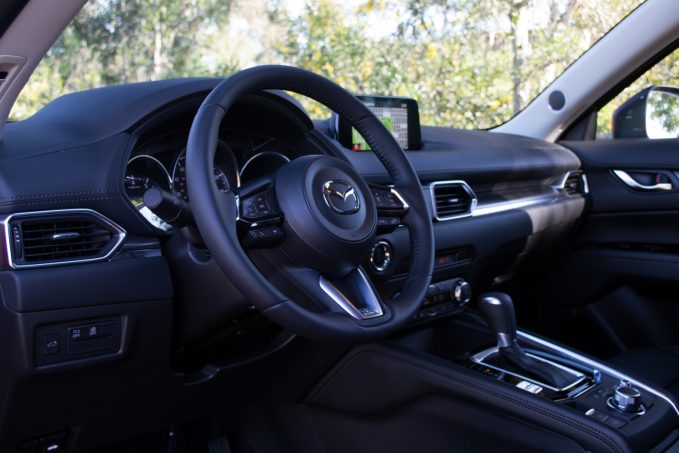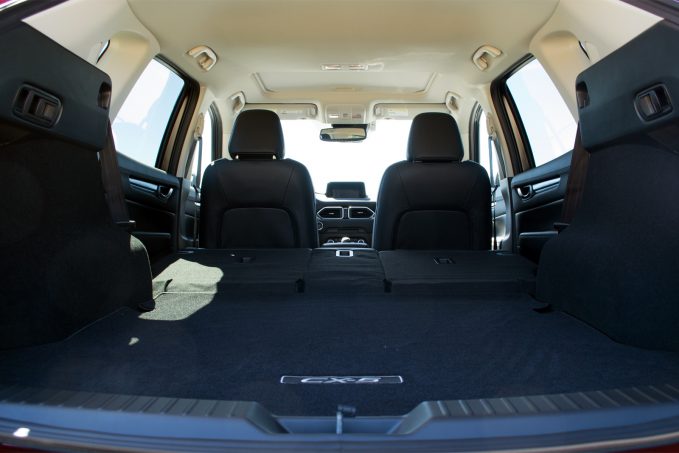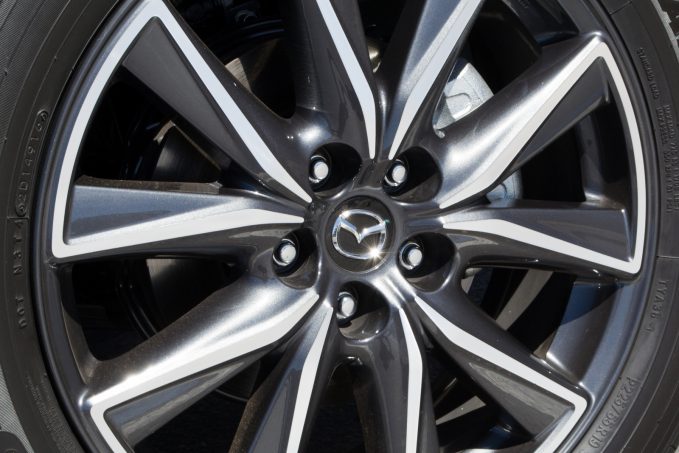When tasked with developing the 2017 Mazda CX-5, the automaker’s team of designers and engineers had one primary directive to follow: Don’t screw it up.
That may seem like an obvious mandate, but it’s a particularly important one for a vehicle that means so much to Mazda globally. After all, the CX-5 has been on a tear since hitting the market back in 2012, and now accounts for almost a third of the brand’s global sales annually. If there ever was a golden goose in Mazda’s lineup, this compact crossover would be it.
Design Evolution
In the face of that make-or-break maxim, the 2017 Mazda CX-5 makes its newness known right away. The original CX-5 was the first of Mazda’s vehicles to feature the so-called KODO design language, and so it’s fitting that this second-gen version gets fitted with the latest iteration of it. While new, the CX-5’s look is clearly an evolution of the original and features a modern take on the same sculpted lines as before.
This is the same styling introduced on the 2017 Mazda CX-9, albeit on a much smaller scale. It also happens to better suit the CX-5’s smaller proportions, and looks far less frumpy — particularly around back.
The story is much the same inside, with the driver-first cabin layout found in the CX-9 — along with the Mazda6 sedan and the recently introduced 2017 Mazda3 — ported over with perfection. It’s a much more modern interior aesthetic, and is matched with materials that feel slightly more upscale this time around — particularly the leather upholstery in top-of-the-line Grand Touring trim.
ALSO SEE: 2017 Jeep Compass Review
The CX-5 adopts the floating infotainment screen used in most of the rest of Mazda’s lineup, which is touch-sensitive while also being controllable through a console-mounted scroll wheel. There’s still no Apple CarPlay or Android Auto smartphone interfacing, though Mazda says it’s coming soon and will be retroactively available.
As part of its driver-focused approach, the CX-5 also gets for the first time an available head-up display that can show relevant driving information like current speed and speed limit, as well as adaptive cruise control settings, among others.
Plenty of Space Inside
Proportionally, the new CX-5 is almost identical to its predecessor. The only variation between the two is the 1.4 inches (35 millimeters) of additional length this time around, putting the CX-5’s bumper-to-bumper length of 179.1 inches (4,549 mm) much closer to that of the segment-leading Honda CR-V. Despite this, the CX-5 still finds itself among the smaller compact crossovers on the market.
That slight increase in overall length does little to impact interior space, though there’s still plenty on tap. Headroom in the first row stands at 39.3 inches (998 mm) with the available sunroof and 39 inches (991 mm) in the second row, both of which put the CX-5 in the conversation for most in the segment. Legroom is likewise respectable, with the 39.6 inches (1,006 mm) in the second row putting the CX-5 among the segment’s best. The CX-5 also benefits from rear doors that open to an impressive 80 degrees, making the second row easy to access.
ALSO SEE: 2017 Honda CR-V Review
Open the tailgate — which can now be done at the push of a button with the addition of an available power unit — and there’s 30.9 cu-ft (875 liters) of cargo room on offer, substantially less than the likes of the CR-V though more than the Kia Sportage and new Jeep Compass. With just 59.6 cu-ft (1,688 liters) of space when the 40/20/40 split-folding second row is out of the way, it’s much the same story — though the CX-5 counters with a few tricks to make up for the shortcomings in space.
The rear cargo opening is wide enough to accommodate larger items without the need to twist and contort them awkwardly, while the rear seats can be folded in three stages uses handles located near the tailgate. There’s also thoughtful change in the cargo compartment, with fabrics that better resist everyday wear and tear replacing hard plastics that are prone to scraping and scratching.
Different Driving Dynamics
And it’s that same thoughtfulness that best sums up most of the changes made to the way the CX-5 drives. Most of the fundamentals have gone largely unchanged this time around, with the focus instead on improving what’s already there.
That certainly applies to the powertrain, at least at launch, with the same setup available as before. All but Canadian base models come powered by the same 2.5-liter gas engine found in the Mazda6, which makes 187 horsepow
er to go along with 185 lb-ft of torque. (Base models in Canada feature a smaller 2.0-liter gas engine that’s good for 155 horsepower and 150 lb-ft of torque, and puts it to the front wheels through a six-speed manual transmission.) The four-cylinder has seen very slight tweaks aimed at improved response and reduced internal friction and knock.
ALSO SEE: Mazda Will Use its Engines to Make its Cars Handle Better
The engine’s power goes to the wheels — either just the front set or all four of them, depending on equipment — through a six-speed automatic transmission that, like the engine, carries over from the outgoing version. It, too, has seen slight tweaks aimed at improving overall smoothness.
The biggest change made to the way the CX-5 drives is the addition of G-Vectoring Control, a software-based system designed to improve overall control and cornering performance. While other automakers use brake-based systems to improve turn-in response, Mazda’s G-Vectoring system uses engine braking in combination with steering input to do so. It’s unlikely all but the most acutely aware will notice the change, though that’s the point.
On-Road Manners
Joining the addition of G-Vectoring Control is a whole host of smaller changes largely aimed at improving the quietness of the CX-5’s cabin, as well as its overall ride quality. Some changes are small ones — windshield wipers that have been lowered below the hoodline, tighter panel gaps and new seals in the door jams — while others are much more drastic. The steering rack, for example, has been mounted directly to the subframe to reduce what little slop and body roll existed in the first-gen CX-5.
ALSO SEE: 2017 Nissan Rogue Review
This CX-5 is a Mazda, after all, which means all the slight tweaks and changes add up to an impressively engaging ride. Throttle response is sharp and swift and leaves the CX-5 feeling spritely, though the engine was left revving high and loud on the winding canyon roads around Campo, Calif., near the United States-Mexico border.
The ride itself is comfortable if a little stiff and truck-like, though very few bumps and road imperfections make their way into the cabin. The steering is also on the firm side and responds well to input without wandering — an added bonus of the G-Vectoring system.
The Verdict: 2017 Mazda CX-5 Review
Given the success of the first-gen CX-5, Mazda stuck with the approach that if it ain’t broke don’t fix it this time around. Not making change for change’s sake, Mazda’s designers and engineers instead worked to fine-tune the compact crossover — and early indications are that it has paid off. Dynamically speaking it’s a Mazda through and through, and is easily the best to drive in the segment. And with plans to introduce a diesel later this year, the CX-5 could be the most well-rounded, too.











